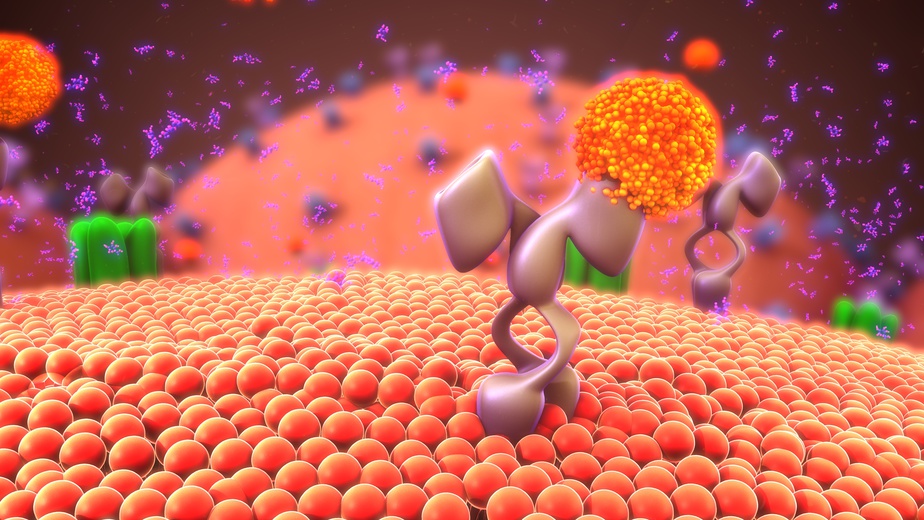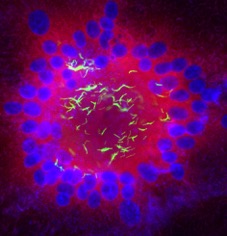Immunity to TB & TB-HIV co-infection
Glycans, lectins and immunity to tuberculosis
Personnel involved
Principal investigator: Yoann Rombouts
Other personnel: Rim Abderrahim, Nelly Gilles
Outline of the project
Host phagocytic cells, including macrophages and dendritic cells, express a wide range of so-called pattern-recognition receptors, including Toll-like receptors (TLRs), NOD-like receptors, and C-type lectin receptors (CLRs), which are involved in recognition of exogenous or endogenous ligands, in antigen presentation and T-cell stimulation, as well as in gene expression rewiring and production of inflammatory mediators, such as cytokines and chemokines.

Among these CLRs, we have identified the C-type lectin DC-SIGN as a key M. tuberculosis receptor in dendritic cells and alveolar macrophages. We have recently furthered our understanding of the role of DC-SIGN in TB by investigating the function of selected mouse DC-SIGN homologues in experimental TB in mice, using various in vivo and in vitro systems. We showed that the DC-SIGN murine homologue SIGNR3 mediates early protection against M. tuberculosis, through recognition of sugar motifs in the mycobacterial cell envelope and induction of protective cytokine secretion.
More recently, we found that the collectin CL-LK is a novel soluble pattern recognition receptor for M. tuberculosis.
CLRs and other mediators of innate and adaptive immunity to the TB bacillus are currently being investigated. In particular we recently found that the C-type lectin DCIR modulates immunity to tuberculosis by sustaining type I interferon signalling in dendritic cells. The molecular mechanisms involved in DCIR signalling are being deciphered.
Lymphoid cells in immunity to TB
Personnel involved
Principal investigators: Denis Hudrisier
Other personnel: Maxime Caouaille, Marion Faucher
Outline of the project
Lymphoid cells comprise innate lymphoid cells (ILCs) endowed with innate functions against microbial pathogens as well as conventional and non-conventional lymphocytes with adaptive functions. The contribution of ILCs to the immune response against Mycobacterium tuberculosis is poorly known. The ability of these cells to react quickly upon infection and to perform anti-microbial functions as well as to control the inflammatory response prompted us to investigate how they contribute to the overall immunity to TB and how their protective potential could be exploited in strategies aiming at manipulating the host response. We have recently initiated a research project along theses line aiming at deciphering the function of these cells in the context of M. tuberculosis infection in both the mouse model and in humans. Regarding lymphocytes, whose critical importance in immunity to TB is well established, it remains unclear how they are associated with protection. With the aim to examine this question we are developing imaging and functional approaches to understand what are the dedicated subpopulations of T lymphocytes that have the best access, interaction and functional properties toward M. tuberculosis infected cells.
Deciphering HIV-TB co-infection
Personnel involved
Principal investigators: Geanncarlo Lugo
Other personnel: Sarah Monard
Project outline
Tuberculosis (TB) and acquired immune deficiency syndrome (AIDS) are among the deadliest diseases due to a single infectious agent. Worsening these public health issues is the fact that the two pathogens responsible for these diseases, Mycobacterium tuberculosis and HIV respectively, are frequently associated. The development of new therapeutic strategies requires a better understanding of the synergistic relationship between M. tuberculosis and HIV-1, including the consequences of co-infection in the human immune system. Indeed, both pathogens are able to impair the host immune response and have a convergent cellular target in macrophages. Both pathogens alter the macrophage microbicidal functions and convert these cells into cellular reservoirs by modulating their activation process.

While the mechanisms for how HIV-1 render the host susceptible to TB are well-known, those responsible for the TB-driven exacerbation of HIV-1 infection are ill defined. We hypothesize that TB induces important changes in the activation and functional program of human macrophages rendering susceptibility to HIV-1.
In the context of co-infection, a predominant hypothesis to explain exacerbation of HIV-1 infection is that Mtb activates macrophages, which in turn create a “bystander” effect to modulate the local environments through inflammatory signals favoring HIV-1 replication. We are currently exploiting different in vitro approaches, including state-of-the-art organoid models, to mimic the bystander effect emanating from sites of Mtb infection to dissect the molecular and cellular mechanisms rendering susceptibility to HIV-1 infection of human monocytes and macrophages. In parallel, within the context of co-infection in vivo, we establish crucial correlations of our in vitro findings in pulmonary lesions of non-human primates and human samples, including sera and pleural effusion fluid. Altogether, the ultimate goal for this project is to deliver novel targets for diagnostic and therapeutic potential against co-morbidity established between AIDS and TB.

